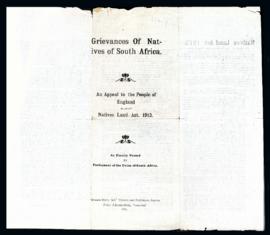Identity area
Reference code
Title
Date(s)
- 1908 - 1962 (Creation)
Level of description
Fonds
Extent and medium
103 boxes
Context area
Name of creator
Administrative history
After the formation of the Union of South Africa in 1910, legislation was enacted which discriminated against the non-White section of the population and increased the racial segregation existing at the time of Union. This angered many Blacks and caused a series of strikes by Black workers. By the 1920s responsible Europeans, particularly churchmen, saw the importance of bringing the races together. Native Welfare Societies, consisting of liberal and philanthropic Europeans, were founded which in due course were replaced by Joint Councils, inter-racial in character.
The Joint Council movement was largely the inspiration of Dr. Thomas Jesse Jones and Dr. J.E.K. Aggrey who in 1921 conducted a study tour of education in South Africa on behalf of the Phelps-Stokes Fund of the United States of America. They had seen the value of inter-racial councils in America and persuaded Dr. C.T. Loram, Chief Inspector of Education in Natal, and his friend J. D. Rheinallt Jones, Secretary of the Witwatersrand Council of Education, to establish a multi-racial organisation with the aim of promoting understanding and goodwill between the races. Rheinallt Jones founded the first Joint Council of Europeans and Africans in Johannesburg in 1921 and by 1931 there were in existence thirty European-African Joint Councils' three European-Indian Joint Councils and a European-Coloured Joint Council was in the process of formation. In all eighty Joint Councils were established, many of them continuing to exist side by side with the Institute of Race Relations after it was founded in 1929. By 1951 only two Joint Councils remained, of which only one was active.
During visits to South Africa in the 1920s Dr. Jesse Jones convinced Rheinallt Jones of the need to set up a national body to centralise interracial activities. The project was made possible by finance from the Phelps-Stokes Fund and the Carnegie Corporation. Rheinallt Jones convened an inter-racial conference in Cape Town in January 1929 which revealed enthusiasm for a national organisation. He called together a committee of seven prominent South Africans not connected with any political party - E.H. Brookes, Professor J. du Plessis, Professor D.D.T. Jabavu, Dr. C.T. Loram, T.W. Mackenzie, J.H. Nicholson and J.H. Pim. They met on 9 May 1929 at the house of the Rev. Dr. R.E. Phillips in Johannesburg, resolved to fern a South African Institute of Race Relations and elected C.T. Loram chairman Howard Pim treasurer and Rheinallt Jones secretary.
With the deaths of Mackenzie end Nicholson and the transfer of Loram to a professorial chair at Yale, the Committee was reduced to six but in 1930 Dr. J.G. van der Horst was added and in 1931 Professor R.F.A. Hoernle, Leo Marquard and Senator Lewis Byron. These ten committee members are regarded as the foundation members of the Institute.
Archival history
In November 1972 the South African Institute of Race Relations transferred various of its archival collections to the University of the Witwatersrand; included were 103 boxes of a collection known as the "B" box. The Institute's archivist advised that the "B" box collection contained the official records of the Institute as distinct from the "R.J." collection which comprised the personal papers of J.D. Rheinallt Jones, director of the Institute. Nevertheless there is much Rheinallt Jones material in the "B" box collection which therefore complements the "R.J."
Immediate source of acquisition or transfer
Content and structure area
Scope and content
The "B" box collection relates mainly to the period 1930 to 1950, although there are some documents as early as 1926 and some all late as 1961. This inventory boar the title "Part I" as there have been subsequent deposits of the Institute's archives which will be inventoried at a later date.
The "B" box collection has been retained as an entity in accordance with Standard archival practice and the files have been kept in their original order. Many of the files overlap and contain material irrelevant to the subject matter of the file. In view of the extensive use made of the collection over the last ten years by researchers who took references according to the then existing arrangement, it was decided not to re-sort. The present box numbers have been retained, but the files which previously bore an alphabetical notation have now been given a numerical one, e.g. the original 4f now becomes 4.6.
This inventory lists the number of items in each file, mention the names of the principal correspondents, indicates the subject field and itemises anything of particular importance. A brief sketch of the Institute is included and a comprehensive index of all personal names mentioned in the inventory and of selective subject fields has been provided, thus bringing together scattered subjects. The words "Native", "African", "Bantu" and "Non-European" have been used where they were the approved nomenclature of the day.
Subjects covered are the social and economic conditions of Blacks, Coloureds and Indians, with particular reference to education, literacy, land, farm labour, labour relations, housing, the urban Black, health and welfare services, medical training, juvenile delinquency, the liquor problem, discriminatory legislation and penal reform. This collection, covering almost three decades, in of great importance to economic, social and political historians.
Anna M. Cunningham, 1 August 1981.
Appraisal, destruction and scheduling
Accruals
System of arrangement
Conditions of access and use area
Conditions governing access
Conditions governing reproduction
Language of material
Script of material
Language and script notes
Physical characteristics and technical requirements
Finding aids
Uploaded finding aid
Allied materials area
Existence and location of originals
Existence and location of copies
Related units of description
Notes area
Alternative identifier(s)
Access points
Subject access points
Place access points
Name access points
Genre access points
Description control area
Description identifier
Institution identifier
Rules and/or conventions used
Status
Level of detail
Dates of creation revision deletion
Language(s)
Script(s)
Sources
Archivist's note
Compiled by Anna M. Cunningham with assistance from Elizabeth Bourne and Marcella Jacobson


